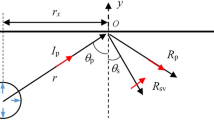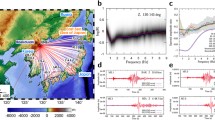Abstract
A theoretical approach is presented to study the ground motion induced by an underground tunnel explosion. The ground motion is caused by two coupled stress waves, i.e., the reflected body wave and the secondary surface wave or Raleigh wave. Based on the principle of conservation of momentum at the wavefronts, the reflected body waves along the ground surface are derived. The interaction of the body wavefront and the ground surface induces the secondary surface wave which transfers outwards on the ground. The particle velocity and particle acceleration on the ground surface are subsequently derived. The analytical results are compared with results from numerical simulations and empirical formulae with different material damping ratios. The effects of the loading density and the material damping on the ground motion are investigated. Finally, the limitations of the proposed theoretical approach for ground motion prediction are discussed.











Similar content being viewed by others
References
Achenbach JD (1973) Wave propagation in elastic solids. North-Holland, Amsterdam
Beresnev IA, Wen KL, Yeh TY (1995) Seismological evidence for nonlinear elastic ground behavior during large earthquakes. Soil Dyn Earthq Eng 14(2):103–114
Crampin S (1981) A review of wave motion in anisotropic and cracked elastic-media. Wave Motion 3(4):343–391
DDESB (2004) US Department of defense explosive safety board, Ammunition and explosive safety standards: DOD 6055.9–STD. Washington, DC
Dowding CH (1996) Construction vibration. Prentice-Hall, Englewood Cliffs
Garvin WW (1956) Exact transient solution of the buried line source problem. Proc R Soc Lond Ser A Math Phys Sci 234:528–541
Hao H, Wu YK, Ma GW, Zhou YX (2001) Characteristics of surface ground motions induced by blasts in jointed rock mass. Soil Dyn Earthq Eng 21(2):85–98
Hendron AJ (1977) Engineering of rock blasting on civil projects. In: Hall WJ (ed) Structural and geotechnical mechanics, a volume honoring NM Newmark. Prentice Hall, New Jersy
Henrych J (1979) The dynamics of explosion and its use. Elsevier Scientific, New York
King MS, Myer LR, Rezomalli JJ (1986) Experimental studies of elastic-wave propagation in a columnar-jointed rock mass. Geophys Prospect 34(8):1185–1199
Kolsky H (1953) Stress waves in solids. Clarendon, Oxford
Langefors U, Kihlstrom B (1978) The modern techniques of rock blasting, 3rd edn. Wiley, New York
Li JC, Ma GW, Zhao J (2009) An equivalent viscoelastic model for rock mass with parallel joints. J Geophys Res 115:B03305
Lu Y, Hao H, Ma GW (2002) Experimental investigation of structural response to generalized ground shock excitations. Exp Mech 42(3):261–271
NATO (2010) AASTP-1 Part III (Edition 1, Change 3), Manual of NATO safety principles for the storage of military ammunition and explosives
Odello RJ (1980) Origins and implications of underground explosives storage regulations. Technical Memorandum, No. 51-80-14. Naval Construction Battalion Center, Port Hueneme
Person PA, Holmber R, Lee J (1994) Rock blasting and explosives engineering. CRC, USA
Singh SP (2005) Blast damage control in jointed rock mass. Fragblast 9(3):175–187
TM 5-1300 (1990) Structures to resist the effects of accidental explosions, Technical Manual TM 5–1300. Department of the Army, Navy, and Air Force, Washington
Wiss JF, ASCE F (1981) Construction vibrations: state-of-the-art. J Geotech Eng Div ASCE 107(2):167–181
Worthington MH, King MS, Marsden JR (2001) Determining the damping factor of sedimentary rocks required for seismically designed structures. Int J Rock Mech Min Sci 38(6):801–806
Zhao J, Zhou YX, Hefny AM, Cai JG, Chen SG, Li HB, Liu JF, Jain M, Foo ST, Seah CC (1999) Rock dynamics research related to cavern development for Ammunition storage. Tunn Undergr Space Technol 14(4):513–526
Zhao XB, Zhao J, Hefny AM, Cai JG (2006a) Normal transmission of S-wave across parallel fractures with Coulomb slip behavior. J Eng Mech ASCE 132(6):641–650
Zhao J, Zhao XB, Cai JG (2006b) A further study of P-wave attenuation across parallel fractures with linear deformational behaviour. Int J Rock Mech Min Sci 43(5):776–788
Zhou YX, Jenssen A (2009) Internal separation distances for underground explosives storage in hard rock. Tunn Undergr Space Technol 24(2):119–125
Acknowledgments
The study is supported by Chinese National Science Research Fund (11072257, 51025935) and the Major State Basic Research Project of China (2010CB732001).
Author information
Authors and Affiliations
Corresponding author
Rights and permissions
About this article
Cite this article
Li, J.C., Ma, G.W. & Zhou, Y.X. Analytical Study of Underground Explosion-Induced Ground Motion. Rock Mech Rock Eng 45, 1037–1046 (2012). https://doi.org/10.1007/s00603-011-0200-3
Received:
Accepted:
Published:
Issue Date:
DOI: https://doi.org/10.1007/s00603-011-0200-3




